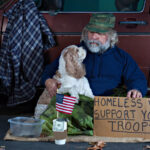Homeless veterans, just seeing the two words strung together is startling. Of course, the problem of homelessness in the United States is nothing new but in the past three years, what has changed is the “face” of the homeless. No longer are the users of shelters and cars single individuals with mental health and substance abuse problems. More and more, the ranks of the homeless are filled with adults and families that lost their housing thanks to:
1. Adjustable mortgage payments that went sky-high as the property lost value and,
2. Unemployment
But it turns out these factors aren’t driving more veterans into the “no-home” zone. In fact what’s happened is the “new” for veterans is in the focused effort that’s underway to end veteran homelessness.
 In the almost forty years since the war in Vietnam ended, the sad image of once proud military men living in alleys and shelters across the country had become familiar along with their grim stories. For most homeless veterans, the path to the street was marked by chronic drug and alcohol abuse often precipitated by PTSD (post traumatic stress disorder) and undiagnosed TBI (traumatic brain injury) that eventually led to loss of jobs, relationships, housing, and dignity. The struggle to assist homeless veterans in the decades between 1965 and 2000 was grim…and then came Iraq, Afghanistan, and Recession.
In the almost forty years since the war in Vietnam ended, the sad image of once proud military men living in alleys and shelters across the country had become familiar along with their grim stories. For most homeless veterans, the path to the street was marked by chronic drug and alcohol abuse often precipitated by PTSD (post traumatic stress disorder) and undiagnosed TBI (traumatic brain injury) that eventually led to loss of jobs, relationships, housing, and dignity. The struggle to assist homeless veterans in the decades between 1965 and 2000 was grim…and then came Iraq, Afghanistan, and Recession.
Veterans: Some Numbers
Over the past decade, what many experts, housing advocates, and military watchers feared was how the intersection of high unemployment, mortgage meltdown, and troop withdrawals from Iraq and Afghanistan would impact the number of homeless veterans already challenging the Department of Veterans Affairs (VA). It turns out, the VA was also keeping close tabs on the situation and made some sweeping changes that are making a difference. As a matter of national pride, not to mention public gratitude, taking care of our military veterans is one area of public policy where Americans are in agreement. But most citizens have no idea what the scope of the problem really is. Here are some numbers that help put it in perspective:
21.8 million: The number of military veterans in the United States in 2010.
Source: 2010 American Community Survey
76,000: Number of sheltered and unsheltered homeless veterans on any given night.
Source: 2010 Supplement Annual Homeless Assessment Report
144,842: Number of veterans using a shelter in 1-year period
Source: 2010 Supplement Annual Homeless Assessment Report
92%: Percentage of homeless veterans who are male
Source: 2010 Supplement Annual Homeless Assessment Report
42%: Percentage of homeless veterans who are between ages 51-61.
Source: 2010 Supplement Annual Homeless Assessment Report
Veterans: Ending Homelessness
Here’s the good news, in 2011, the number of homeless veterans had decreased from 2010. Recent efforts to focus resources on eliminating “veterans” as a category in the “homeless” lexicon seem to be working and in a recent phone conversation with Pete Dougherty, Director of Homeless programs for the VA, he talked about the fundamental change in the Department’s approach to homeless veterans: Prevention. But what does that mean?
According to Director Dougherty, that means the VA along with other federal departments such as Labor and Housing and Urban Development, have taken on President Obama’s 2009 challenge to end veteran homelessness by 2015. Here are some of the changes that have taken place:
Aggressive outreach; finding homeless veterans and those at-risk
Increase in health, mental health, and drug treatment options
Support services to keep veterans in their homes
More emergency shelter beds and supportive housing
Mortgage assistance
Dollars for employment support
Direct grants to community agencies to provide/coordinate services
In his annual talk session with the Senate Armed Services Committee, Director Dougherty has said the federal government is on track to meet the goal of eliminating veteran homelessness. Time will tell if he’s right, the signs are positive. But for now, the challenge of vets without a permanent place to sleep remains.

